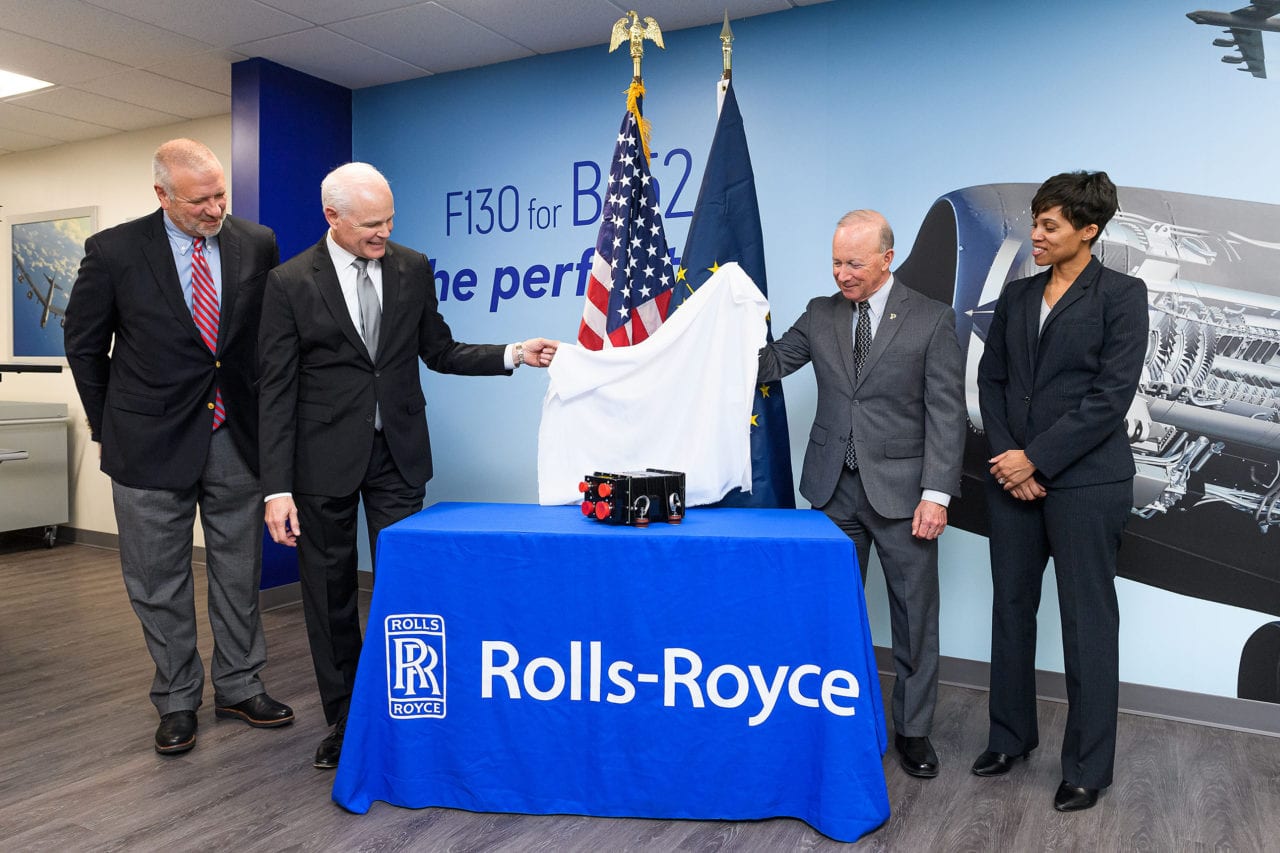
Unveiling an electronic engine controller for the Rolls-Royce AE 3007H jet engine during an announcement of a new engine controls facility in Discovery Park District in West Lafayette, Ind. this week are from left Brian Edelman, president of Purdue Research Foundation; Tom Bell, president of defense and CEO of Rolls-Royce North America; Mitch Daniels, Purdue University president; and Candice Bineyard, director of defense programs for Rolls-Royce North America. (Photo: Purdue University)
Rolls-Royce has launched new electronic engine controllers (EECs) for DoD aircraft, including the Rolls-Royce AE 3007 engines on U.S. Navy MQ-4C Triton and U.S. Air Force RQ-4 Global Hawk surveillance drones by Northrop Grumman, the AE 3007 engine on the Navy MQ-25 Stingray refueling drone by Boeing, and the Rolls-Royce proposed F130 engine for the Air Force’s B-52H Commercial Engine Replacement Program (CERP). A final CERP RfP is expected in the next month.
The laptop sized EECs improve fuel efficiency and reduce pilot and drone system workload by monitoring and controlling gas turbine engines through adjusting air and fuel flow, for example, and freeing the pilot or drone system to focus on the mission.
“The first EEC has been completed and will be delivered to the Rolls-Royce facility in Indianapolis, where it will be installed on an AE 3007H engine,” George McLaren, a Rolls-Royce spokesman, wrote in a March 11 email to Avionics International. “The engine will then be shipped to Northrop Grumman in the near future [for the Triton aircraft].”

On left, Tom Bell, president of defense and CEO of Rolls-Royce North America, stands with Gregory Jackson, a controls engineer for Rolls-Royce North America. Jackson built the first AE3007H electronic engine controller produced in West Lafayette, Indiana. Photo: Purdue University Rebecca McElhoe
Rolls-Royce is building and testing the EECs in West Lafayette, Ind. near Purdue University, and the company has partnered with the Purdue Research Foundation for the project.
The Air Force has awarded prototype CERP contracts to Rolls-Royce, General Electric, and Pratt & Whitney, which supplies the bomber’s legacy TF33 engines, which have powered the Buff fleet since the 1960s. While Rolls-Royce is pitching its F130 engine for CERP, P&W plans to offer its PW815 engine, and GE is likely to offer its CF34-10 or Passport engines.
The Air Force expects to spend $7 billion to $8 billion on CERP as part of an effort to keep the B-52H flying until 2050.
The draft CERP RfP lays out a requirement for an Electronic Engine Control System (EECS) – an “engine-mounted Full-Authority Digital Engine Control (FADEC) system, including B-52 specific FADEC software (developed and qualified) consistent with EPS [Engine Procurement Specification] requirements.”
The Air Force CERP effort is an accelerated one. “The contractor shall deliver CERP Engines (Rapid Prototype) within 18 months of delivery order issuance,” according to the draft RfP. “The contractor shall deliver the CERP engines (Rapid Prototype) to be utilized for initial B-52 CERP integration and test activities within 36 months from contract award via delivery order anticipated to occur approximately 18 months from contract award.”